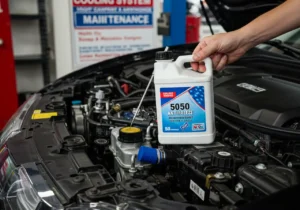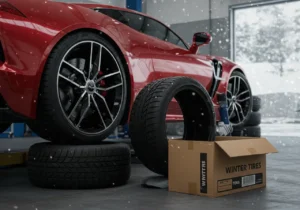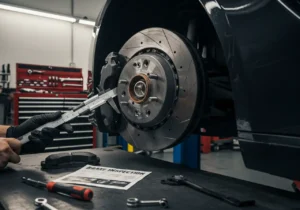Maintaining a high-performance vehicle requires time and resources, but the benefits are definitely worth it. A seasonal maintenance checklist for high-performance vehicles ensures top performance and durability throughout the year. Seasonal maintenance involves specific tasks designed to tackle the unique challenges posed by different weather conditions.
For high-performance vehicles, it’s essential to stay proactive by using a detailed seasonal maintenance checklist to prevent potential problems. This approach not only helps maintain peak performance but also prolongs the life of your vehicle, making sure it stays dependable and efficient.
 1. Regular Preventive Maintenance
1. Regular Preventive Maintenance
Regular preventative maintenance is crucial in preventing major issues and ensuring that your high-performance vehicle operates at its best. Key maintenance tasks include:
- Oil and Filter Changes: Changing the oil and filter regularly is essential for maintaining engine health. High-performance engines tend to work harder, making it necessary to replace oil every 3,000 to 5,000 miles or as specified by the manufacturer.
- Tire Pressure Checks: Maintaining proper tire pressure ensures optimal contact with the road, promoting safety and fuel efficiency. Check tire pressure monthly and adjust according to the manufacturer’s recommendations.
- Tread Depth Inspection and Tire Rotation: Inspecting tread depth helps identify uneven wear patterns that could affect handling. Rotating tires every 5,000 to 8,000 miles helps achieve balanced wear and extends tire life.
- Air Filter Inspections: A clean air filter is vital for engine performance and fuel efficiency. Inspect air filters during each oil change and replace them if they appear dirty or clogged.
- Fluid Level Monitoring: Regularly check all fluid levels, including brake fluid, coolant, transmission fluid, and power steering fluid. Proper levels are crucial for the vehicle’s performance and longevity.
Consistent attention to these elements helps maintain your vehicle’s high-performance capabilities while preventing potential breakdowns or costly repairs.
 2. Tire Care for Enhanced Performance
2. Tire Care for Enhanced Performance
Maintaining optimal tire condition is essential for getting the best performance out of any high-performance vehicle.
Tire Rotation
Rotating your tires every 5,000 to 7,500 miles reduces uneven tread wear. Even wear translates to consistent grip and responsive handling, both critical for performance driving. Regular rotation also extends the overall lifespan of each tire, reducing the frequency of costly replacements.
Winter Tires
If you drive in areas with cold winters, standard summer or all-season tires quickly lose effectiveness below 45°F (7°C). Switching to dedicated winter tires ensures maximum traction on snow and ice by using softer rubber compounds and specialized tread patterns. High-performance vehicles benefit from this swap as it preserves agility and braking performance even in challenging conditions.
Consistent attention to tire care not only optimizes road contact but also directly impacts safety and control at any speed.
3. Battery Testing and Maintenance
Temperature changes can greatly affect how well batteries work in high-performance vehicles. Hot summers can cause internal damage, while freezing winters make it harder for the battery to provide power, leading to unexpected failures. Batteries that work perfectly in moderate weather may have trouble when temperatures drop or rise.
Regular testing is a must on any seasonal maintenance checklist for high-performance vehicles. Before summer or winter begins, use a multimeter or a special battery tester to check the voltage and cranking amps. Look out for slow engine starts and dim lights—these are clear signs that your battery might be nearing the end of its life.
Here are some tips for effective battery maintenance:
- Schedule battery inspections with every oil change or at least twice a year.
- Check terminals for corrosion and make sure connections are secure.
- Replace batteries showing signs of weakness or age, instead of waiting for a breakdown.
A strong, dependable battery ensures your vehicle performs at its best no matter the weather.
4. Windshield Wiper Maintenance for Safety
Maintaining clear visibility is crucial when driving a high-performance vehicle, especially in heavy rain, snow, or sleet. Windshield wipers are essential for your safety as they provide an unobstructed view of the road. Even the most advanced lighting and driver-assist systems cannot make up for dirty or streaky glass.
Here are some tips for maintaining your windshield wipers:
- Inspect your windshield wipers annually. Check for signs of wear, such as cracking, splitting, or missed spots on each wipe.
- Replace wipers at least once a year, or sooner if you notice decreased performance. Use high-quality blades that are designed for your specific climate, such as winter wiper blades with rubber shields, for better durability.
- Make sure to keep the windshield washer fluid reservoir filled with a good-quality formula that prevents freezing and helps remove dirt and salt.
By ensuring that your windshield wipers are in good condition, you will be prepared for any weather conditions that may arise, without compromising performance or safety.
5. Cooling System Maintenance with Antifreeze Levels Check
Cooling system maintenance is crucial for preventing your high-performance vehicle from overheating and maintaining optimal engine temperature. The cooling system plays a vital role in ensuring that your engine runs smoothly by dissipating heat and preventing excessive thermal build-up.
Preventing Overheating
The cooling system, which includes components like the radiator, water pump, and thermostat, ensures that the engine does not reach dangerously high temperatures. Regular inspections should be conducted to identify any leaks, corrosion, or blockages that could impair the system’s efficiency.
Maintaining Engine Temperature
Consistent cooling system checks are essential in maintaining the correct engine temperature. An overheated engine can lead to severe damage and costly repairs. Ensuring that the coolant is at the proper level and mixture ratio (typically 50/50 coolant to water) aids in optimal temperature regulation.
Preventing Freezing in Winter
During colder months, it is essential to check antifreeze levels regularly to prevent the coolant from freezing. A frozen cooling system can cause cracks in the engine block and other critical components. Utilizing a hydrometer can help you measure antifreeze concentration and ensure adequate protection against freezing temperatures.
Routine maintenance of the cooling system is indispensable for high-performance vehicles to maintain their peak operating conditions throughout different seasons.
 6. Brake System Checks for Safety
6. Brake System Checks for Safety
A high-performance vehicle’s stopping power is only as reliable as its brake system. Consistent and responsive braking is essential for safe driving, especially when pushing your car to its limits. On any reputable Seasonal Maintenance Checklist for High-Performance Vehicles, brake system inspection always ranks high.
Key areas to focus on:
- Brake Pads: These components absorb friction and wear down with every stop. Worn-out pads can lead to longer stopping distances and noisy braking. Inspect thickness regularly—replace pads before they reach minimum specifications.
- Rotors: Rotors provide the surface for pads to grip. Over time, rotors can develop grooves or warping, reducing their effectiveness and causing vibrations during braking. Have rotors measured for thickness and checked for surface irregularities at every seasonal service.
- Brake Fluid: Hydraulic pressure is what gives you a confident pedal feel. Brake fluid absorbs moisture over time, which can reduce its boiling point and result in spongy brakes or brake fade under heavy use. Bleed and replace brake fluid according to your manufacturer’s recommendations, typically every 1–2 years, or sooner if you track your vehicle.
Neglecting these checks risks not just performance loss but also significant safety hazards.
Adhering to a disciplined maintenance cycle keeps your vehicle’s braking system sharp and ready, ensuring you retain full control regardless of speed or road conditions. Each checkpoint on this list supports the integrity of your entire brake system—an absolute necessity when performance and safety matter most.
7. Check Your Suspension Components for Better Handling
If you want your high-performance vehicle to handle like a dream and provide a comfortable ride, you need to pay attention to its suspension system. The suspension is what keeps your tires in contact with the road, giving you precise control and stability.
When Should You Inspect Your Suspension?
As a general rule of thumb, it’s a good idea to have your suspension components checked every 50,000 miles or as recommended in your vehicle’s manual. This way, any wear and tear can be fixed before it becomes a big problem.
What Should You Look For?
When inspecting your suspension, make sure to give special attention to the following parts:
- Shocks and Struts: Look out for any signs of leakage, damage, or excessive wear on these components. If your shocks are worn out, you’ll feel every bump on the road, and your handling will suffer.
- Bushings, Ball Joints, and Control Arms: These parts also play a crucial role in your suspension’s performance. Make it a habit to check them periodically and replace them when needed.
By keeping an eye on these components and addressing any issues promptly, you’ll be able to maintain the handling capabilities of your vehicle and enjoy a smoother driving experience. Plus, it’ll go a long way in ensuring your safety on the road!
8. Exterior Protection Against the Elements
Vehicle waxing is a critical aspect of maintaining the exterior of your high-performance vehicle. Regular waxing offers several benefits that go beyond mere aesthetics, playing a crucial role in safeguarding your car’s paintwork from various environmental damages.
Benefits of Vehicle Waxing
Here are some key advantages of regularly waxing your vehicle:
- Protection from UV Rays: Just like how sunscreen protects your skin, waxing shields your vehicle’s paint from the sun’s harmful UV rays, which can cause fading and oxidation over time.
- Guard Against Contaminants: Road salt, bird droppings, tree sap, and industrial pollutants can damage your car’s finish. A good wax layer acts as a barrier against these contaminants, preventing them from reaching and harming the paintwork.
- Water Resistance: Waxing creates a hydrophobic layer on your vehicle’s surface, causing water to bead up and roll off easily. This helps in reducing water spots and minimizes the risk of rust forming due to prolonged exposure to moisture.
- Enhanced Shine: Regular waxing maintains the glossy finish of your car, making it look newer for longer. This not only enhances its visual appeal but can also increase its resale value.
Recommended Waxing Frequency
Applying wax at least twice a year is recommended for optimal protection. Use quality car wax products and consider professional detailing services for an even more thorough application. Investing time in this simple yet effective task ensures that your high-performance vehicle remains pristine and protected against the harsh elements it encounters throughout the seasons.
9. Advanced Diagnostic Tools and Comprehensive Inspections by Experienced Technicians
Modern high-performance vehicles rely on sophisticated onboard systems that can only be fully assessed with advanced diagnostic tools. During a seasonal maintenance checklist for high-performance vehicles, these digital tools provide precise readings and uncover issues not detectable through visual inspection alone.
Diagnostic scans
Tools such as OBD-II scanners interpret fault codes from engine management, transmission, ABS, and electronic stability systems. Early detection of sensor malfunctions or software irregularities prevents minor problems from escalating.
Specialized equipment
High-end diagnostic platforms like Bosch KTS or Autel MaxiSys offer real-time data analysis—ideal for pinpointing subtle performance drops, misfires, or fluctuating fuel trims.
Technician expertise
Experienced technicians interpret the data generated, ensuring nothing is overlooked. They can calibrate advanced driver-assistance systems (ADAS), update firmware, and perform adaptations specific to high-performance models.
A thorough seasonal inspection using these technologies strengthens reliability and maintains the precise engineering standards your vehicle was designed for.
Conclusion
Regularly following your High-Performance Vehicle Maintenance Checklist is essential for keeping your car reliable and enjoyable to drive. Every task on your Seasonal Maintenance Checklist for High-Performance Vehicles, whether it’s checking fluids or performing advanced diagnostics, plays a crucial role in maintaining performance, safety, and value.
By being diligent with seasonal maintenance, you’ll encounter fewer unexpected issues, gain more confidence while driving, and have the opportunity to appreciate your car’s capabilities fully. The key to transforming an average drive into an exhilarating experience lies in consistent and thorough upkeep.
Stay dedicated to each maintenance task, and you’ll be rewarded with a high-performance vehicle that continues to impress season after season.

 1. Regular Preventive Maintenance
1. Regular Preventive Maintenance 2. Tire Care for Enhanced Performance
2. Tire Care for Enhanced Performance 6. Brake System Checks for Safety
6. Brake System Checks for Safety